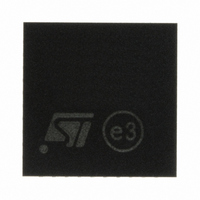SN260Q STMicroelectronics, SN260Q Datasheet - Page 14

SN260Q
Manufacturer Part Number
SN260Q
Description
IC ZIGBEE/802.15.4 PROC 40-QFN
Manufacturer
STMicroelectronics
Datasheet
1.SN260Q.pdf
(47 pages)
Specifications of SN260Q
Frequency
2.4GHz
Modulation Or Protocol
802.15.4
Applications
ZigBee™
Power - Output
-32dBm ~ 5dBm
Sensitivity
-97.5dBm
Voltage - Supply
2.1 V ~ 3.6 V
Current - Receiving
35.5mA
Current - Transmitting
35.5mA
Data Interface
PCB, Surface Mount
Antenna Connector
PCB, Surface Mount
Operating Temperature
-40°C ~ 85°C
Package / Case
40-QFN
For Use With
497-6404 - BOARD EVAL SPZB260 MOD FOR STR9497-5990 - KIT EVAL REVA FOR ZIGBEE497-5879 - NETWORK DEVELOPMENT FOR SN260497-5877 - KIT RADIO CARRIER FOR SN260
Lead Free Status / RoHS Status
Lead free / RoHS Compliant
Memory Size
-
Data Rate - Maximum
-
Functional description
6
6.1
6.1.1
6.1.2
14/47
Functional description
The SN260 connects to the Host platform through either a standard SPI interface or a
standard UART interface. The EmberZNet Serial Protocol (EZSP) has been defined to allow
an application to be written on a host platform of choice. Therefore, the SN260 comes with a
license to EmberZNet, the Ember ZigBee-compliant software stack. The following brief
description of the hardware modules provides the necessary background on the operation
of the SN260. For more information, contact your local ST sales representative.
Receive (RX) path
The SN260 RX path spans the analog and digital domains. The RX architecture is based on
a low-IF, super-heterodyne receiver. It utilizes differential signal paths to minimize noise
interference. The input RF signal is mixed down to the IF frequency of 4MHz by I and Q
mixers. The output of the mixers is filtered and combined prior to being sampled by a
12Msps ADC. The RX filtering within the RX path has been designed to optimize the co-
existence of the SN260 with other 2.4GHz transceivers, such as the IEEE 802.11g and
Bluetooth.
RX baseband
The SN260 RX baseband (within the digital domain) implements a coherent demodulator for
optimal performance. The baseband demodulates the O-QPSK signal at the chip level and
synchronizes with the IEEE 802.15.4-2003 preamble. An automatic gain control (AGC)
module adjusts the analog IF gain continuously (every ¼ symbol) until the preamble is
detected. Once the packet preamble is detected, the IF gain is fixed during the packet
reception. The baseband de-spreads the demodulated data into 4-bit symbols. These
symbols are buffered and passed to the hardware-based MAC module for filtering.
In addition, the RX baseband provides the calibration and control interface to the analog RX
modules, including the LNA, RX Baseband Filter, and modulation modules. The EmberZNet
software includes calibration algorithms which use this interface to reduce the effects of
process and temperature variation.
RSSI and CCA
The SN260 calculates the RSSI over an 8-symbol period as well as at the end of a received
packet. It utilizes the RX gain settings and the output level of the ADC within its algorithm.
The linear range of RSSI is specified to be 40dB over all temperatures. At room
temperature, the linear range is approximately 60dB (-90 dBm to -30dBm).
The SN260 RX baseband provides support for the IEEE 802.15.4-2003 required CCA
methods summarized in
standard; Mode 0 is a proprietary mode.
Table
3. Modes 1, 2, and 3 are defined by the 802.15.4-2003
SN260












